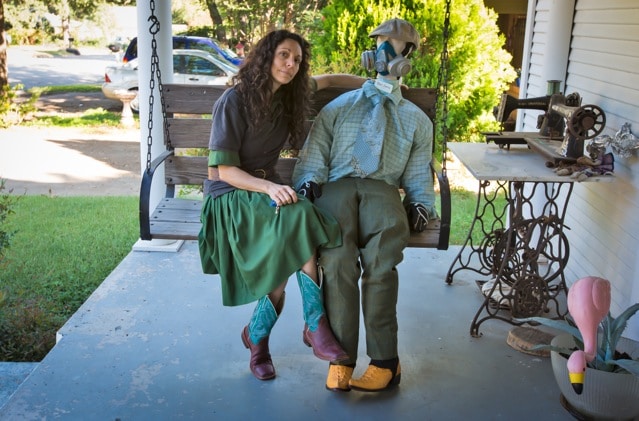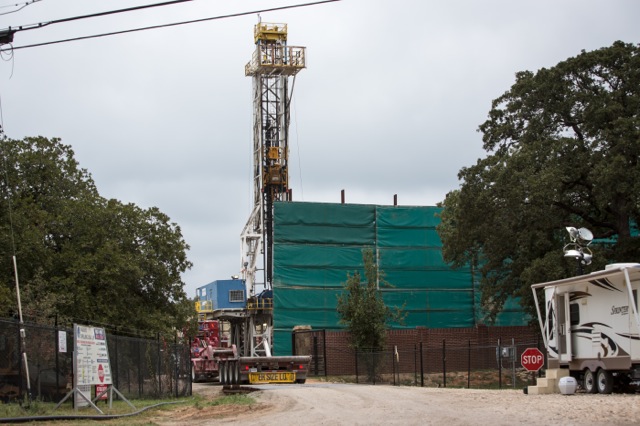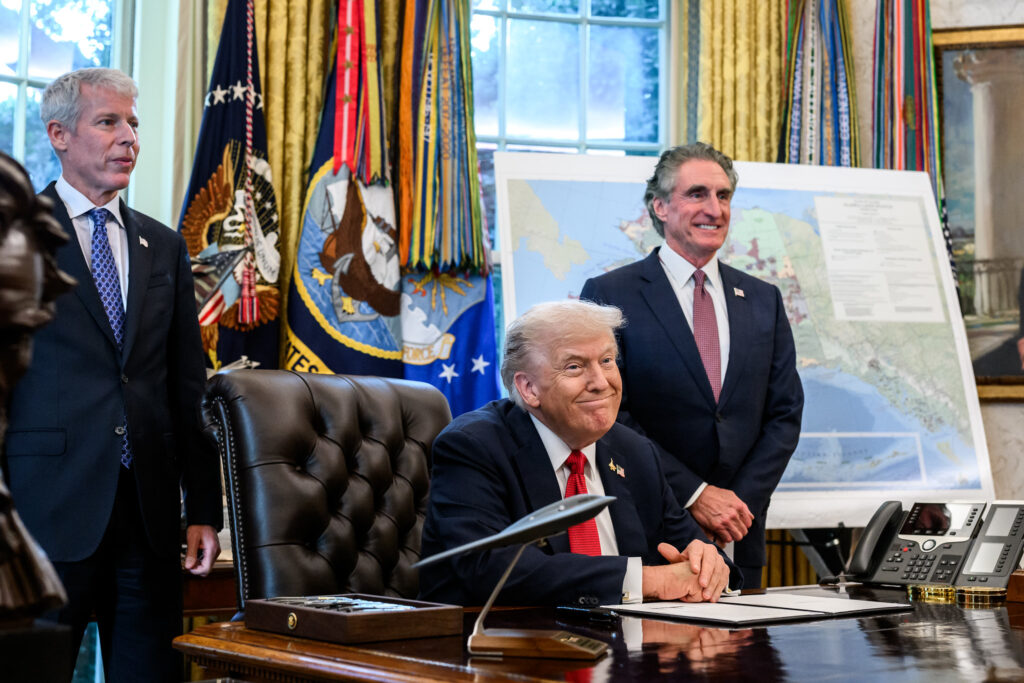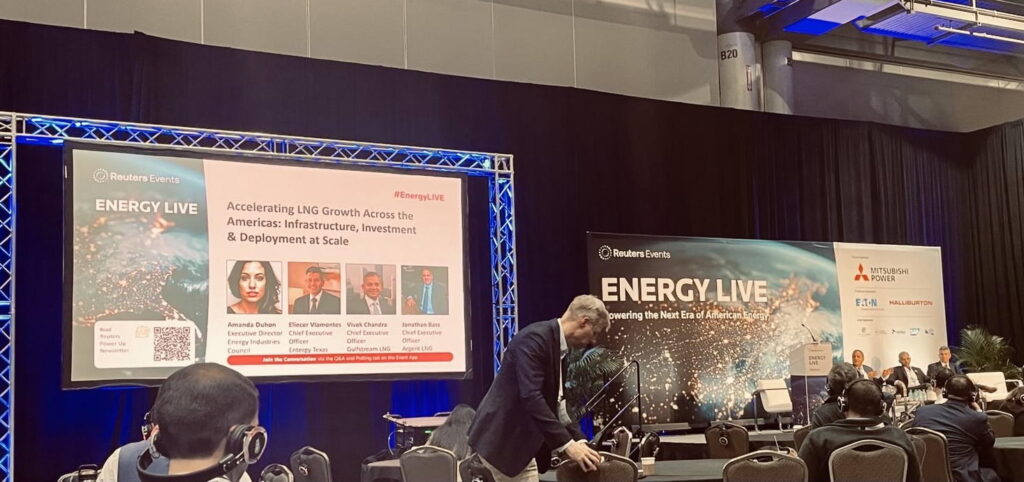Fort Worth was the first major city in America to allow extensive fracking within the city limits — but it wasn’t the last. Arlington, Texas, fell to the frackers next — only this time, the frackers were required to make their installations less of an eyesore.
Berms were built up around fracking sites and compressor centers to hide them from view, and active drill sites have temporary walls built up around them to keep the noise down. But walls don’t stop chemical seepage.
Fracking site in Arlington, Texas, a suburb of Dallas. ©2013 Julie Dermansky
Kim Feil, an educator, blogger and environmental activist, is no stranger to chemical exposure. She moved from New Sarpy, Louisiana, part of an area known as Cancer Alley due to its many refineries and high incidence of cancer, to Arlington, before the fracking began.
Feil monitors new industrial developments and does what she can to stop them by attending city-zoning meetings. Her blog keeps neighbors informed about what is coming next and which fracking installations are having problems. Other concerned citizens share heartbreaking stories with her about sicknesses they believe are connected to fracking.
Since the fracking began, Feil’s husband has been diagnosed with cancer, she started experiencing migraines and her son has a biomarker for an adrenal tumor.
Though it is difficult to directly link illness to industrial pollution with the present limited scientific data, she has no doubt that the new and troubling health problems around her are connected to fracking.
Earthworks released video footage that documents chemicals escaping into the air at frack sites, captured with an infrared camera. Though the naked eye can’t see chemicals escaping from water storage holding tanks and frack sites, infrared cameras can. Cancer-causing chemicals associated with fracking include hydrogen sulfide, sulfur dioxide and methane.

Kim Feil on her front porch in Arlington with dummy ‘Ben Zene,” a prop she brings with her when protesting fracking. ©2013 Julie Dermansky
Ranjana Bhandari and her family live in an upscale area of Arlington. She turned down an $18,000 per acre bonus for her mineral rights, only to find that the Texas Railroad Commission could strip those rights from her by applying Rule 37.
A law originally meant to protect property owners, Rule 37 has been interpreted by frackers in a way that enables them to seize the drilling rights when a landowner refuses to sign a lease after most of their neighbors have consented.
Bhandari’s challenge to Chesapeake Energy resulted in a hearing before the Texas Railroad Commission. The commission ruled in Chesapeake’s favor.
According to Reuters, Texas Railroad Commission spokesperson Ramona Nye said the agency believes there is no evidence that fracking is unsafe. Evaluating the fairness of Rule 37 exceptions is not part of the commission’s mandate, she said.
Ranjana Bhandari in front of solar panels on her home in Arlington, Texas. ©2013 Julie Dermansky
Bhandari doesn’t have the means to hire a lawyer and take the case further. Although she couldn’t stop her land from being fracked, she is glad she never consented.
At a meeting on October 10th, at the Preston Royal Library in Dallas, FracDallas director Marc W. McCord gave a talk on fracking’s impact on the water supply. McCord went over the staggering figures: two to six million gallons of water are used for each well, threatening to further deplete an already dangerously low water supply. According to Mr. McCord’s presentation, “in the Barnett Shale the range is about 1.5 to 9 million gallons with an average of about 5 million gallons per well. In the Eagle Ford the average is about 9 million gallons with a high of about 13 million gallons.”
Although industry representatives point out fracking uses only one percent of Texas water, that statistic is misleading since water use is not the same in all areas.
In areas such as Arlington, Fort Worth and south of San Antonio, which are facing worsening drought conditions, taking any portion of water out of public use threatens to leave cities entirely dry.
McCord also dispelled the talking point that natural gas burns cleaner than coal. “The energy used to retrieve fracked gas and oil is more carbon intensive than burning coal,” he says. “The problem isn’t using the gas, but getting it.”
Marc W. McCord, Director of FracDallas, speaks at the Preston Royal Library. ©2013 Julie Dermansky
Although the long-term effects of fracking are still being debated, some of the risks involved in harvesting this unconventional energy source are already clear.
Millions of gallons of water are removed from public use — water that cannot be recycled due to contamination and must be removed from the water supply for good. The hydrogen sulfide released from fracking sites can be lethal. Gas pipelines can explode. And recent studies show fracking is causing earthquakes.
Fueling the debate are oil and gas corporations that have compromised scientific studies by underwriting them and are starting to run “native advertisements” that blur the line between news and advertising.
To frack in densely populated cities increases the potential risk to life and property exponentially. Whatever financial boon fracking can bring, it can also lower property values if the water and air become contaminated.
Dallas has safeguarded the city with zoning restrictions, which make fracking within city limits unattractive. Residents of Dallas who keep an eye on Arlington and Fort Worth have seen enough of fracking’s downsides to spur them to keep fracking outside the city limits — for now.
[Update: On December 11th, the Dallas City Council passed an ordinance that restricts drilling within 1500 feet of residences and other protected sites including schools and churches.]
Watch an animated display about fracking at the Forth Worth Museum of Science and History:
Subscribe to our newsletter
Stay up to date with DeSmog news and alerts









